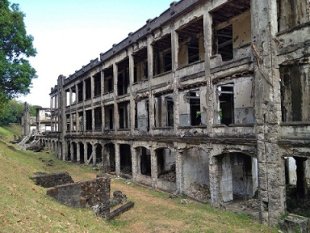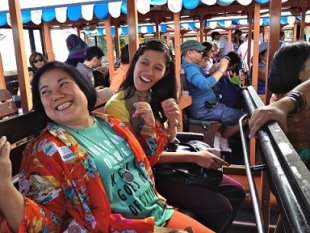.JPG) |
| Truckload of Sugarcane along Nasugbu, Batangas |
I've been to a lot of places in almost a year and I saw it fit to kick-off my 2012 summer blog with something about our unplanned road trip to Batangas in time for my kids' summer vacation.
The goal was to look for new beach spot south of the metro. It shouldn't cost an arm and a leg but should have white sand, a pool, and a feel of exclusivity in a tropical forest setting.
We searched the Internet and Tripadvisor the night before our trip. I printed some maps and target spots then went to sleep.

We were up late (around 9am), prepared our stuff good for 2-3 days, and had breakfast at McDonalds near our village. We discussed our options of either taking the Sto. Tomas (towards Laiya) or Sta. Rosa (towards Nasugbu or Calatagan) exits. We called up 2 places in Laiya and reserved for 2 days just in case we won't be able to discover a new spot.
While at SLEX, we decided to exit at Sta. Rosa towards Tagaytay and even thought of going to Taal. The trip, being a Holy Monday, was easy going up to Tagaytay that we eventually decided to look for some places in Calatagan.
 |
| St. John the Baptist, Lian, Batangas |
Still, the kids went down the car to take some pics.
It took us 2.5 hours to get to Calatagan. We heard from the locals that the Stilts was the best place in Calatagan.
Unfortunately, the sea was rough and the Stilts Beach Resort was fully booked.
Though we decided to look for Ronco beach which was in our map, we couldn't find it and ended up in a single-lane paved road which was really scary. This was way after Playa Calatagan. There were no structures on either side of the road and some farmers beside the road gave us questioning stares -- as if asking, "where the hell are these guys going?"
On the way back, we still gave Calatagan a shot. We passed by this old rustic blue-roofed house with a Suntan-lined long driveway. It had a small round-about infront of the house. The kids gave it one look and said that it looked like scary mansion more than a resthouse.
 |
| Calatagan beach as seen from the road |
 |
| View from SLEX |
We drove towards Nasugbu. We had one more shot for day. We could stay at Johndel or El Cacar in Barangay Wawa for the night then head off to the pricey Canyon Cove in the morning.
 |
| Old-style Mercury Drug, Nasugbu town proper |
 |
| Fisherman on their way to work at dusk |
In 10 minutes, we were on board the banca captained by "Ama," a veteran with more than 20 years experience. We securely parked our car at Aling Ana's residence (she is the caretaker). Overnight parking is 200 pesos and the cost of the banca (round-trip) ranges from PhP1,200 for a direct deal, and PhP1,500 it goes through a peddler.
Costa De Oro
.JPG) |
| Costa De Oro beach line |
Costa de Oro is located in Barangay Natipuan, Nasugbu, Batangas.
It's the same area where the rich and famous have their rest houses in this part of Batangas. The houses dot the coastline and beside the hilly areas of the island. You would also notice that the more affluent have their yachts parked on the shore.
.JPG) |
| Resort's own banca (P1,200 fee round-trip) |
It didn't appear in any Internet searches and was believed to be known only to locals and foreigners (mostly Japanese). There is no road leading to it. Just reachable by banca or yacht.
However, club members of Terraza can gain access to it via a 5-minute walk from the beach, and those from far away Munting Buhangin can walk the beach in about 15 minutes. Otherwise, it's faster and more enjoyable to reach the place via banca ride if you come from other parts of the island.
 |
| The Main Villa |
 |
| Living area (Main Villa) |
 |
| Main pool and lanai |
The long beach is shared by the more exclusive Terraza and Canyon Cove. There are 2 more small resorts in the area where locals usually stay to rent cottages for the day. Some even bring their own tent.
 |
| Typical food fare: Freshly grilled Lobsters & Tuna! |
How much does it cost?
For 2 days, inclusive of all the frills, fresh bounty and banca ride, it only cost us less than P20,000! There were 5 of us. Not bad, eh?
Things to Note:
 |
| The author amidst the forest |
2) You need a banca to get to the island.
3) Stay away from peddlers if you want to make the most of your money.
4) Discover the Islands of the Philippines
======================================================
HOMER NIEVERA Business Development in Digital Media http://homernievera.net

